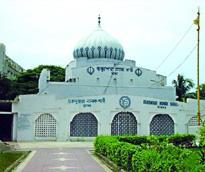Gurudwara Nanak Shahi
Gurdwara Nanak Shahi the main Sikh gurdwara in Bangladesh, is situated on the campus of the university of dhaka near the arts faculty building. At one time it was known as 'Sujatpur Sikh Sangat', as it was situated in what was then Sujatpur mouza. It is believed to have been built on the initiative of a Sikh priest, Almast, sent by the sixth Sikh guru, Hargobind Singh (1595-1644), during the reign of Emperor jahangir. Some others believe it was built by the ninth Sikh guru, Teg Bahadur Singh (1621-75), and that from here communication was maintained with other Sikh gurdwaras in Bengal, Bihar and Orissa.
This shrine, commemorating Guru Nanak's visit, is located close to the Dacca University. For some years in the recent past, the place had suffered neglect, and it was on the 2nd January 1972, after the liberation of Bangladesh, that Sri Guru Granth Sahib was installed again at the shrine. The room where the congregation met was 9 by 9 meters. Towards the left is an ancient tank, newly cleared of debris, with a baoli in its midst.
The Gurdwara was founded by a missionary sent to Bangladesh by Baba Gurditta, son of Guru Hargobing (6th Guru) within 17th century and was completed in 1830. Religious celebrations include weekly prayers every Friday. Social functions such as Baishakhi are celebrated. Old relics-an old handwritten volume of Guru Granth Sahib, a copy of the Portrait of Guru Teg Bahadur and Guru Teg Bahdur's sandals are preserved here Suitable accommodation is available for visitors.
Gurdwara Nanakshahi in Ramana behind the public library adjoining the Dacca University campus, was originally an Udasi Charan-Paduka founded by Baba Nath, successor of Bhai Almast, in memory of Guru Nanak Dev. When Guru Tegh Bahadur was at Dacca during the late 1660s, Bhai Nattha was the Udasi mahant and Baba Bulaki Das the Guru's masand here. On the eve of the Partition, possession and priesthood was the subject of court cases between Baba Tribeni Das and another claimant Gobind Das, and later between Tribeni Das and one Manik Lal. Ultimately Tribeni Das was adjudged the lawful guardian of the Gurdwara, but in the wake of the Partition, he left for India never to return. A Sikh, Swarn Singh looked after this place in his absence. In 1960-61, the east Pakistan Government passed order to acquire 1.40 acres of the 1.63 acres of walled premises of the Gurdwara. Baha Swarn Singh challenged the government in lower courts and ultimately in Dacca High Court. The case was pending there when Indo-Pak War started in December 1971. On or about 14th December 1971, Baba Swarn Singh was murdered alongwith his Muslim friend Muhammad-ul-Malik. Their bodies were buried side by side in the later's house. After the conclusion of the war three days later, a Sikh deputation was sent from Takht Sri Patna Sahib to Dacca. With the help of Sikh soldiers the members of the deputation led by Captain Bhag Singh of Calcutta recovered possession of the Gurdwara, cleaned it and held a congregation in it on 2nd January, 1972. Even Sayyad Nazar-ul-Islam, then acting President of Bangla Desh attended the congregation and gave assurance about the safety and reconstruction of this and the other Gurdwaras.
In the past it had an entrance from the north, a ditch and burial ground on the south, and a pond on the west with concrete steps to the water. Apart from the main temple there were a number of rooms for accommodating devotees. In all, there were nine rooms. On the north-east of the main temple there was an office and on the east the granthi (priest) had his residence.
From 1915 to 1947, Sri Chandrajyoti served as the granthi. After 1947 the gurdwara was neglected and almost abandoned. After the liberation of Bangladesh, however, it was repaired and revived. There is a management board, which includes local as well as foreign members, to run the affairs of the gurdwara.
The gurdwara is open to all, irrespective of race, religion, caste or sex. The place of prayer is known as 'darbar sahib' and has entrances on all sides, unlike other places of worship. At the northern end of the prayer hall a copy of the holy book of the Sikhs, the granth shahib, is kept on a wooden platform. A pair of wooden sandals, believed to belong to Guru Teg Bahadur Singh, has been preserved in a glass box just under the Granth Sahib.
The daily religious rites at the gurdwara include reading from the Granth Sahib and recital of prayers. Every Friday a weekly assembly is held from 11 am to 1 pm. The chief granthi reads from the Granth Sahib. kirtan and prayers continue for over two hours. The prayer service ends with the distribution of food. There are also arrangements to distribute food in the morning. Sikhs regard this as a way of enhancing understanding among people.
There are also about eight or nine smaller gurdwaras in different parts of Bangladesh. The Bangladesh Gurdwara Management Committee runs the affairs of these gurdwaras with financial support from the devotees, foreign visitors, donors and grants from the Bangladesh government. [Sambaru Chandra Mohanta]
Location: Neelkhet Road, Ramna, Dhaka (Bangladesh)

